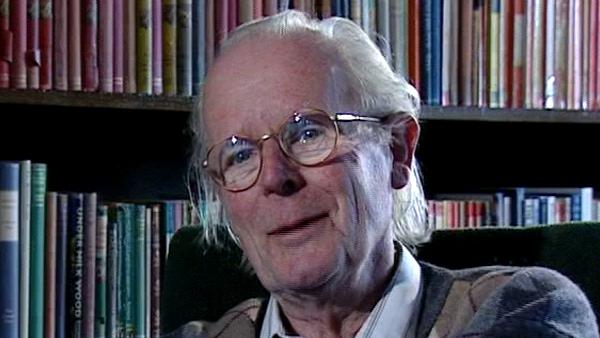NEXT STORY

Two theories on sexual inequality
RELATED STORIES

NEXT STORY

Two theories on sexual inequality
RELATED STORIES


|
Views | Duration | |
|---|---|---|---|
| 71. Penicillin | 600 | 02:05 | |
| 72. How bacteria transfer genetic material | 576 | 01:03 | |
| 73. The process of transfer in bacteria | 480 | 03:39 | |
| 74. Operons: JG Roth and JR Lawrence. Jacob and Monod | 565 | 04:23 | |
| 75. Adaptation at the organism level | 551 | 01:00 | |
| 76. James Watson and Francis Crick transformed biology | 1320 | 00:42 | |
| 77. Viviparity may be a big evolutionary mistake! | 1 | 546 | 02:49 |
| 78. Are mammals stuck with sex? | 576 | 03:54 | |
| 79. Dolly the sheep, and would you clone yourself? | 713 | 01:58 | |
| 80. Sheila Maynard Smith | 1 | 797 | 03:34 |


We've never actually worked together on... on a problem. It's not been a deliberate decision, we've never said, 'We will not work together.' But I do think it would be tempting providence in a way. I mean, marriage is not the easiest of relationships, I mean, we've been married for 57, 58 years or something now, quite a while, anybody who could put up with either of us for that length of time, you know, it's not the easiest thing to do. But if you've known one, a really close research collaboration, it's very like a marriage. It has just the same kind of tensions and potential jealousies and potential feelings of being let down, all the things that can threaten a marriage can threaten a research collaboration. And I have seen several research collaborations between people whom I... I loved and whom I really liked to see the joint work, break up, rather as marriages could break up, in recrimination and mutual, sort of, distrust and so on. To try and bring both off in one relationship would, I think... I think it would be terribly hard. But on the other hand, it has been a great advantage to Sheila and me that we've... I mean, she worked as an engineer while I was engineering as well, and we married when we were students but... we went to the same place to work when we were working on aeroplanes.
[Q] She also made the switch from engineer to biologist then?
No, no, she's not an engineer - I'm not allowed to say she's a mathematician, because she's - actually, it's quite true, she's not a mathematician, but she took her first degree in mathematics. And if you took a degree in mathematics and it was wartime, you were employed as an engineer. And she sort of picked up the engineering on the way. And then she had a biggish break for producing kids, you know. Then, when, you know, the youngest was old enough to go to nursery to be looked after and so on, she wanted to get back into some sort of work and actually worked in human genetics, at University College, which was nice because... I mean, she wasn't working directly for Haldane but she was working for Haldane's colleague, Lionel Penrose, and we were all in the same department, so that was a good relationship. And then, when we came down here, there's no medical school, and there was no way she could go on being a human geneticist. You can't be a human geneticist without a medical school because you can't let blood out of people, even, you know, unless you've got a medical colleague. And I had this colleague, Neville Simons, who was working on bacterial genetics, and so Sheila decided to become a bacterial geneticist. If you can add and subtract, you can do anything in science, I believe. I mean, all the detail you can learn, but to have a mathematic... an ability to think logically and clearly, which you get if you're a mathematician, I think you can take it anywhere.
[Q] Do you talk shop a lot, even though not actually collaborating on particular research?
Oh yes, yes. We've always talked about the work we're doing. That... it may be one of the reasons why we've put up with one another for so long, I don't know.
The late British biologist John Maynard Smith (1920-2004) is famous for applying game theory to the study of natural selection. At Eton College, inspired by the work of old Etonian JBS Haldane, Maynard Smith developed an interest in Darwinian evolutionary theory and mathematics. Then he entered University College London (UCL) to study fruit fly genetics under Haldane. In 1973 Maynard Smith formalised a central concept in game theory called the evolutionarily stable strategy (ESS). His ideas, presented in books such as 'Evolution and the Theory of Games', were enormously influential and led to a more rigorous scientific analysis and understanding of interactions between living things.
Title: Sheila Maynard Smith
Listeners: Richard Dawkins
Richard Dawkins was educated at Oxford University and has taught zoology at the universities of California and Oxford. He is a fellow of New College, Oxford and the Charles Simonyi Professor of the Public Understanding of Science at Oxford University. Dawkins is one of the leading thinkers in modern evolutionary biology. He is also one of the best read and most popular writers on the subject: his books about evolution and science include "The Selfish Gene", "The Extended Phenotype", "The Blind Watchmaker", "River Out of Eden", "Climbing Mount Improbable", and most recently, "Unweaving the Rainbow".
Tags: University College London, Sheila Maynard Smith, Lionel Penrose, Neville Simons
Duration: 3 minutes, 35 seconds
Date story recorded: April 1997
Date story went live: 24 January 2008